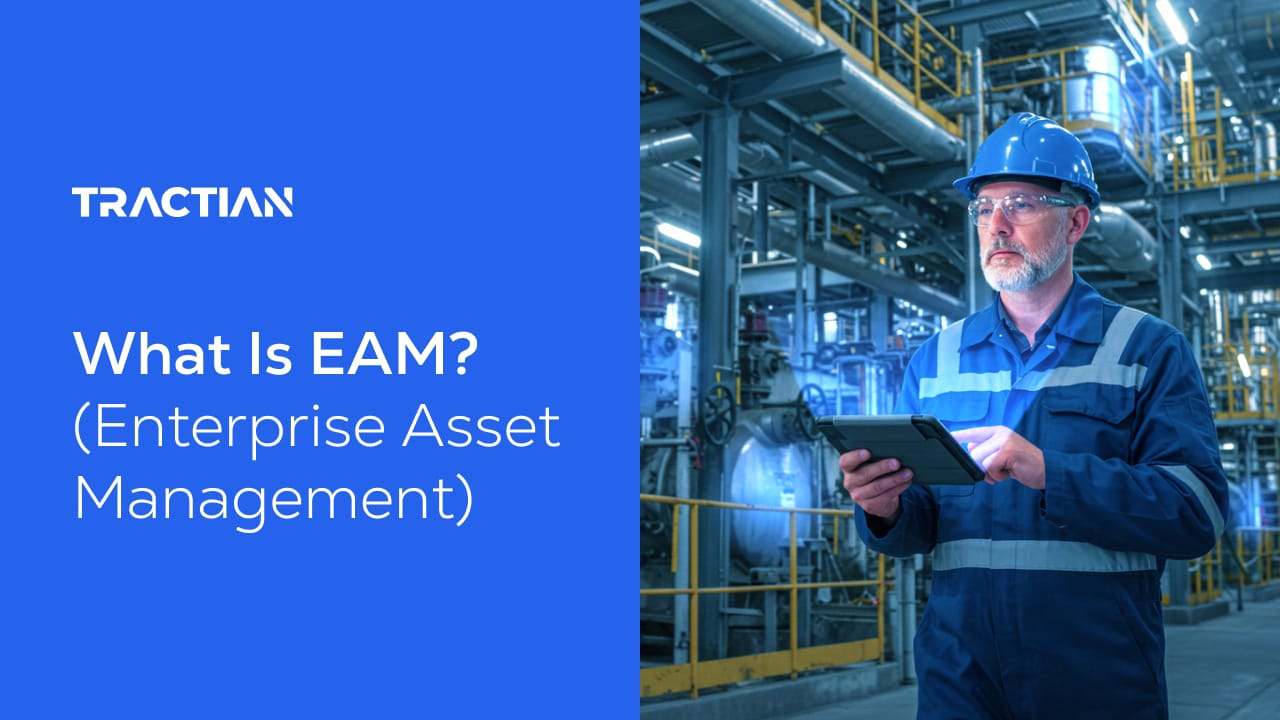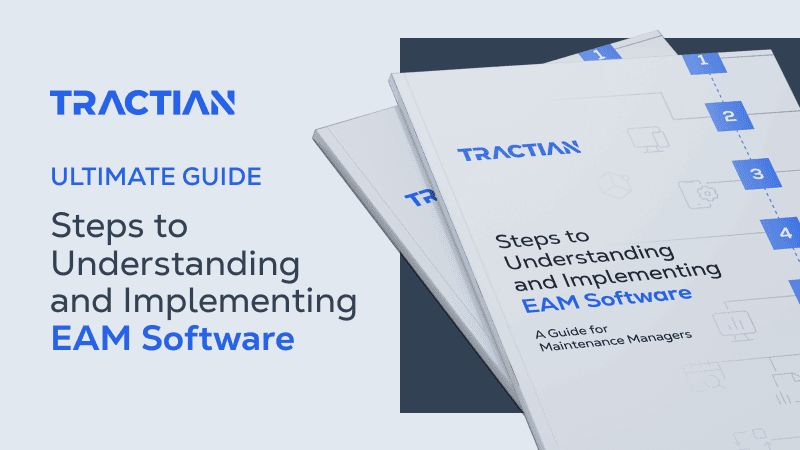As technology drives and develops industrial operations and efficiency is a top priority for maintenance managers, effective asset management has never been so critical.
Market-leading companies recognize the need for robust and comprehensive systems to manage, monitor, and optimize their physical assets.
In this scenario, Enterprise Asset Management (EAM) software steps in to take a leading role.
This guide is for maintenance managers and other professionals who are evaluating or initiating the implementation of an EAM system in their organizations.
What is EAM (Enterprise Asset Management)?
Enterprise Asset Management (EAM) is the systematic process of managing an organization’s physical assets throughout their lifecycle.
Phases in this process include planning, acquisition, operation, maintenance, and eventual disposal of assets.
EAM systems enable businesses to maximize the performance and value of their assets while minimizing costs and risks.
How Does an EAM System Work?
Enterprise Asset Management (EAM) systems function by integrating advanced tools, technologies, and workflows to streamline asset management across the organization.
Here’s a more detailed breakdown of how EAM systems work:
- Asset Monitoring: EAM systems rely on IoT sensors and real-time data collection to monitor asset conditions. This includes tracking metrics such as temperature, vibration, and runtime to detect potential issues early.
- Centralized Database: All asset-related information is stored in a centralized platform. Stored information enables teams to access and update data seamlessly, including asset history, maintenance schedules, work orders, vendor details, and compliance documentation.
- Work Order Management: EAM systems streamline work order creation, assignment, and tracking. Technicians can receive tasks, update progress, and close out jobs through mobile devices, improving efficiency and communication.
- Lifecycle Management: EAM systems manage every stage of an asset’s lifecycle, from procurement to decommissioning. This ensures assets are utilized effectively and replaced or retired at the optimal time.
- Predictive Maintenance: EAM systems use advanced analytics and AI to predict when equipment is likely to fail. This allows organizations to schedule maintenance proactively, minimizing downtime and repair costs.
- Integration with Other Systems: EAM platforms often integrate with ERP systems, CMMS tools, and supply chain management software. Interconnectivity enhances overall operational efficiency and ensures seamless data flow between departments, such as procurement and finance.
- Mobile Accessibility: Technicians and managers can access the EAM system via mobile devices, enabling real-time updates, remote work order management, and on-the-go decision-making.
- Reporting and Analytics: EAM systems generate comprehensive reports on asset performance, maintenance history, and costs. These insights enable organizations to make data-driven decisions to improve efficiency and reduce expenses.
- Compliance and Safety: EAM systems help organizations create a safer work environment by automating compliance tracking and safety checks that maintain regulations and avoid penalties.
By combining these functionalities, EAM systems enable organizations to maximize asset utilization, reduce costs, and maintain operational excellence.
The Evolution of EAM
Over the years, Enterprise Asset Management (EAM) has undergone a significant transformation, evolving alongside technological advancements and changing business needs.
Below is a detailed look at its evolution:
Early Days: Manual and Paper-Based Systems
Asset management was predominantly manual in the early stages, relying on paper-based records and spreadsheets.
This approach was prone to errors, inefficiencies, and difficulties in tracking asset performance over time. Organizations struggled with ensuring timely maintenance and managing asset data effectively.
The Introduction of CMMS (Computerized Maintenance Management Systems)
The advent of CMMS (Computerized Maintenance Management Systems) marked a major milestone in asset management. CMMS introduced digital tools for scheduling, tracking, and documenting maintenance tasks.
It replaced paper systems, offering improved accuracy and better record-keeping. However, CMMS primarily focused on maintenance activities, excelling in scheduling and tracking maintenance tasks. While it does not typically manage the entire asset lifecycle, it remains a highly effective tool for organizations that prioritize maintenance operations.
Emergence of EAM as a Comprehensive Solution
The need for a more holistic approach emerged as businesses grew and asset portfolios became more complex.
EAM systems were developed to complement and expand on CMMS capabilities. These systems incorporated asset lifecycle management, financial planning, and broader operational oversight.
EAM systems integrated financial management, compliance tracking, and performance monitoring into a single platform.
Modern EAM: Integration with Advanced Technologies
Today, EAM systems harness cutting-edge technologies to enhance asset management:
- IoT (Internet of Things): Sensors and connected devices provide real-time asset monitoring, enabling predictive maintenance and smarter decision-making.
- AI and Machine Learning: AI-powered predictive analytics help organizations forecast asset failures and optimize maintenance schedules.
- Cloud Computing: Cloud-based EAM solutions offer scalability, remote access, and cost efficiency.
- Mobile Accessibility: Technicians can manage assets and work orders on the go, improving efficiency and response times.
Why is Enterprise Asset Management Important?
EAM is essential for organizations looking to optimize asset performance, reduce costs, and mitigate risks. By centralizing asset data and enabling predictive maintenance, EAM systems help:
- Extend the lifespan of critical assets.
- Ensure compliance with safety and regulatory standards.
- Enhance decision-making through real-time insights.
- Boost operational efficiency and customer satisfaction.
{Free Material} EAM Software: A Guide for Maintenance Managers
What is the Difference Between EAM and CMMS?
While Enterprise Asset Management (EAM) and Computerized Maintenance Management Systems (CMMS) support asset management, their focus areas differ. Many organizations use CMMS for maintenance operations, while others choose EAM to oversee the entire asset lifecycle.
Here’s a more detailed comparison of EAM and CMMS:
Scope and Coverage
- EAM: Manages the entire asset lifecycle, from acquisition and operation to maintenance and disposal. It integrates multiple processes, such as financial planning, procurement, compliance, and sustainability management. EAM provides a holistic view of asset performance, aligning asset management with organizational goals.
- CMMS: Primarily focuses on maintenance management. It helps schedule, track, and document maintenance tasks such as work orders, inspections, and repairs. CMMS is more maintenance-centric and does not typically include financial management or procurement features.
Functional Depth
- EAM Features: EAM systems include advanced capabilities such as predictive analytics, supply chain management, asset lifecycle management, vendor management, and service contract management. They are designed to handle complex asset portfolios across multiple locations.
- CMMS Features: CMMS tools specialize in streamlining maintenance tasks, such as generating work orders, tracking maintenance schedules, and managing spare parts inventory. They are particularly beneficial for organizations where maintenance is the central focus, providing a cost-effective and efficient solution.
Integration with Other Systems
- EAM seamlessly integrates with broader enterprise systems like ERP, supply chain management tools, and financial planning platforms, ensuring a unified asset and resource management approach.
- CMMS: Often integrates with maintenance-specific tools and smaller operational systems, but lacks the broader integration capabilities of EAM systems.
Target Users
- EAM: Ideal for organizations with diverse, complex asset portfolios that require comprehensive asset lifecycle management, such as manufacturing plants, utilities, and transportation networks.
- CMMS: Best suited for organizations prioritizing maintenance efficiency, regardless of size. Many companies use CMMS effectively to manage maintenance operations while integrating with other enterprise systems as needed.
What Are the Benefits of EAM Systems?
Maximize Asset Life
EAM systems help organizations monitor asset health, perform preventive maintenance, extend asset lifespans, and reduce replacement costs.
Work from Anywhere
Cloud-based EAM solutions provide mobile access, enabling teams to manage assets and tasks remotely.
Minimize Downtime
Predictive analytics and condition monitoring allow organizations to address potential issues before they lead to unplanned downtime.
Simplify Audits
Centralized asset data and automated reporting make regulatory compliance and audits more straightforward.
Centralize Asset Data
EAM systems consolidate all asset-related information, enabling seamless collaboration and improved decision-making.
Improve Benchmarking and Asset Performance Management
Organizations can analyze performance trends and set benchmarks to optimize asset utility and efficiency.
Modernize Maintenance Operations
EAM systems streamline maintenance processes with features like real-time tracking, automated workflows, and IoT integrations.
Boost in Mechanical Efficiency
EAM ensures equipment operates at peak efficiency, reducing energy consumption and operational costs.
Drop in Maintenance Costs
Proactive maintenance and resource optimization lower overall maintenance expenses.
Key Features of Effective EAM
Work Management: Efficiently manage work orders, prioritize tasks, and allocate resources.
Phases of Maintenance: Plan, execute, and analyze maintenance activities to ensure asset reliability.
Planning and Scheduling: Optimize maintenance schedules to reduce downtime and improve resource utilization.
Supply Chain Management: Streamline procurement and inventory processes to ensure the availability of critical spare parts.
Health and Safety: Ensure compliance with safety regulations and mitigate risks through proactive monitoring and management.
Mobile Maintenance: Mobile-enabled EAM systems allow technicians to access and update information on the go.
Analytics: Leverage data insights for predictive maintenance and strategic decision-making.
Cloud: Cloud-based EAM solutions offer scalability, flexibility, and cost-efficiency.
Work Order Management: Streamline work order creation, assignment, and tracking.
Asset Lifecycle Management: Manage assets from acquisition to disposal, ensuring maximum ROI.
Safety Regulation: Automate compliance tracking and ensure adherence to safety standards.
Labor Management: Optimize workforce scheduling and track labor costs effectively.
Service Contract Management: Monitor service agreements and vendor performance to ensure accountability.
Financial Management: Track asset-related costs and support budgeting and financial planning.
Reporting and Analytics: Generate detailed reports and gain actionable insights to improve asset performance.
Vendor Management: Centralize vendor data and streamline communication for better coordination.
Document and Knowledge Management: Store and manage critical documents, manuals, and training materials in a centralized repository.
How Does EAM Work with Existing Systems?
EAM systems integrate seamlessly with existing enterprise systems like ERP, CMMS, and supply chain management software.
This ensures a unified approach to asset management and improved cross-departmental collaboration.
Why Would an Organization Use CMMS Instead of EAM?
Organizations may choose CMMS (Computerized Maintenance Management Systems) over EAM (Enterprise Asset Management) based on their specific operational needs. CMMS is an excellent choice for maintenance-focused organizations, while EAM provides additional asset lifecycle management and financial planning capabilities.
Simpler Asset Management Requirements
CMMS is ideal for organizations that primarily focus on maintenance tasks. It is a highly effective solution for businesses seeking to optimize maintenance workflows without the added complexity of full asset lifecycle management.
Businesses with straightforward operations, such as small manufacturing plants or local facilities, often find CMMS sufficient for their needs.
Cost-Effectiveness
CMMS solutions are generally more affordable than EAM systems for organizations with limited budgets.
They provide core maintenance management features without the additional complexity or expense of broader asset management functions.
Ease of Implementation
CMMS systems are simpler to implement compared to EAM, making them attractive for businesses looking for quick deployment.
Training requirements are typically lower, allowing teams to start using the system faster.
Maintenance-Centric Focus
CMMS is purpose-built for maintenance activities, such as generating work orders, scheduling preventive maintenance, and tracking repairs.
Organizations that prioritize these functions over asset lifecycle management benefit from the streamlined focus of CMMS.
Lower Complexity
EAM systems are designed to manage large-scale, complex asset portfolios and often require integration with multiple enterprise systems, such as ERP.
For smaller organizations or those with less complex operations, the comprehensive scope of EAM may be unnecessary.
Industry-Specific Use Cases
Certain industries or sectors, such as hospitality or small retail businesses, with limited asset diversity or simpler maintenance needs, may prefer CMMS due to its targeted functionality.
Scalability Needs
In summary, CMMS is an excellent choice for organizations with a primary focus on maintenance management, cost constraints, or straightforward operational needs.
EAM offers additional capabilities for businesses requiring comprehensive asset management and strategic planning. However, CMMS remains a powerful and effective solution for organizations with a strong maintenance focus.
Asset Monitoring and Management with EAM
- Centralize Asset Information: Consolidate data for better visibility and decision-making.
- Resolve Issues Before They Happen: Use predictive analytics to prevent failures.
- Monitor Assets Smarter: Leverage IoT and real-time data for intelligent monitoring.
- Maximize Asset Utilization: Optimize resource allocation and reduce idle times.
- Manage Aging Assets and Infrastructure: Extend the lifespan of older assets through targeted maintenance.
- Elevate Maintenance Management: Improve processes with automation and analytics.
- Consolidate Operational Applications: Use a single platform for all asset management tasks.
How Can EAM Preclude Liability for an Organization?
EAM systems ensure compliance with safety regulations and standards, reducing the risk of accidents and legal liabilities.
Centralized documentation and audit trails also help organizations address compliance inquiries efficiently.
How Will EAM Help Companies Combat Climate Change?
Enterprise Asset Management (EAM) systems contribute to sustainability initiatives by optimizing energy usage, minimizing waste, and improving operational efficiency.
They also enable organizations to track and reduce their carbon footprint while empowering them to optimize asset performance and reduce costs.
EAM systems, with their advanced features and integrations, are essential for modern businesses aiming to maximize their assets' value and streamline operations.
Maximize Uptime & Efficiency with Tractian CMMS/EAM
The best asset management strategy isn’t about choosing between EAM and CMMS-it’s about finding a solution that combines the strengths of both to drive efficiency, reliability, and long-term value. That’s precisely what Tractian CMMS/EAM delivers.
With Tractian’s AI-powered platform, companies can move beyond traditional maintenance software and into a world where real-time asset intelligence, predictive maintenance, and seamless operational oversight are built into every workflow.
- Total Asset Visibility: Track and monitor your assets with real-time condition data, ensuring you always know the status of your equipment.
- Intelligent Workflows: Automate work order management, streamline preventive maintenance, and ensure teams focus on the tasks that matter most.
- AI-Driven Insights: Leverage predictive analytics to reduce downtime, extend asset lifespan, and make data-driven decisions with confidence.
- Seamless Integration: Connect Tractian CMMS/EAM with ERP, inventory management, and financial planning tools to ensure a fully integrated operational ecosystem.
- Industrial Copilot: Tractian is more than just software-it‘s a proactive partner in helping your teams optimize their maintenance strategy rather than reactively fixing what’s broken.
- Maintenance Planning & Scheduling: Ensure maintenance tasks are properly scheduled and prioritized, preventing last-minute disruptions and optimizing resource allocation.
- Inventory Management & Optimization: Prevent overstocking, reduce costs, and ensure seamless operations by tracking inventory levels, usage trends, and replenishment needs in real time.
By bridging the gap between EAM and CMMS, Tractian CMMS/EAM provides a single, intuitive platform that enhances every aspect of asset and maintenance management. Whether you’re looking to streamline daily maintenance operations or implement a long-term asset strategy, Tractian ensures you have the right tools to maximize uptime, improve efficiency, and stay ahead of potential failures.
Discover how Tractian CMMS/EAM can transform your operations. Schedule a demo today and see the future of asset management in action.


